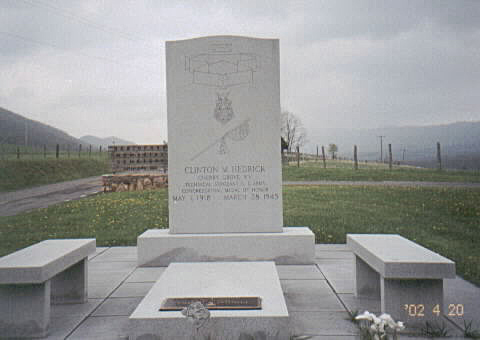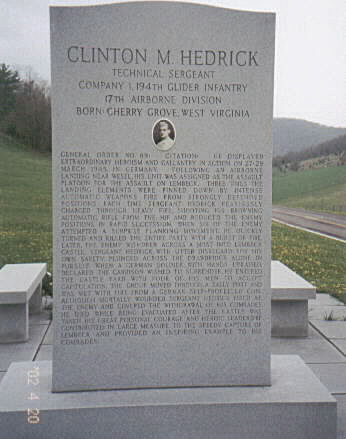

Remember...
Clinton Monroe Hedrick
1918-1945
"Hedrick was an extraordinary man, an extraordinary solder and extraordinary leader:a hero in every sense of the word."
William R. Hunter

|
Remember...Clinton Monroe Hedrick
|
Army Technical Sergeant Clinton Monroe Hedrick was born in Cherry Grove, West Virginia, on May 1, 1918, and died heroically in action on March 28, 1945, in Lembeck, Germany. His parents were Preston Stephen Hedrick, born September 16, 1880, at Upper Tract, Pendleton County, and May Artie Bennett Hedrick, born on December 30, 1890, in Pendleton County. He also had five full siblings, each born in Pendleton County: Marie M. Hedrick (married name: Mallow), born June 16, 1914; Junior Kenny Hedrick, born August 6, 1920; Virginia Doris Hedrick (married name: Eye), born May 15, 1923; Sudia Ann Hedrick (married name: Wyatt), born July 31, 1926; and Elsie Lou Hedrick (married name: Vance), born May 18, 1930. He also had two older half-siblings, who were born in Pendleton County: Lillie Belle Hedrick (married name: Kimble), born April 12, 1902, and Curtis Hedrick, born December 23, 1906.
Fortunately, for posterity, Clinton's family is certainly not lacking in its historians. One of Clinton's cousins, Ruth Elaine Bennett (married name: Teem), was around the age of 16 and attending high school at the time Clinton enlisted in the Army. She was especially passionate about historic preservation and has contributed to the study and preservation of the history, culture, genealogy, and heritage of West Virginia. While she did not personally know Clinton, she knew he was a local hero and one of the most famous men from her part of West Virginia. She has contributed information regarding Clinton to the West Virginia Veterans Memorial, and her son, Paul Lloyd Teem Jr., has honored not only the memory of Clinton, but also her work, by contributing much of the information within this article.
On September 5, 1940, Clinton Monroe Hedrick enlisted in the armed forces at Fort Hayes, Columbus, Ohio. Clinton fought bravely alongside his comrades in the 550th Infantry Airborne Division throughout the majority of the war. From December 16, 1944, to January 25, 1945, the division fought in the infamous Battle of the Bulge and suffered heavy casualties, so much so, that the 550th Infantry Airborne Division no longer existed and the remaining soldiers were parceled out into other infantry units. Clinton was transferred to Company I, 194th Glider Infantry, 17th Airborne Division, where he rose to the rank of technical sergeant.
Clinton's younger brother, Junior Kenny Hedrick, a graduate of Circleville High School, also served as a sergeant in the U.S. Army during World War II. Junior enlisted on September 25, 1943, at Clarksburg, received the Good Conduct Medal, and was honorably discharged on February 9, 1946.
The 17th Airborne Division was to accompany the British 6th Airborne Division during what would be the last full scale airborne operation of the war, Operation Varsity:the Airborne Assault on the Rhine. This operation would also be the 194th Glider Infantry Regiment's very first glider landing, which would become a shaky and daring situation for the glider troops. The 194th's mission was to land north of Wesel in Landing Zone S (a large flat area where the Issel River and the Issel Canal merge) and seize the crossing over the Issel and protect the Division's right flank.
The mission started out on a precarious note when the 194th had the misfortune of flying over a concentration of German antiaircraft weapons. The Germans' relentless firing destroyed or damaged two-thirds of the C-47s (U.S. military transport aircraft) of the 194th. The pilots remained with the aircraft until they released the gliders, which landed amid the German artillery units. The German gun crews immediately repositioned their guns for direct fire, but the glider troops prevailed and were able to overrun the German positions.
By mid-afternoon on March 24, 1945, the 194th had secured its objective, including the destruction of 42 artillery pieces and 10 tanks and the capture of 1,000 German prisoners. By March 26, Field Marshal Montgomery had sufficient forces on the German side of the river to move eastward. The next day, as the 194th advanced toward the town of Lembeck, the regiment was confronted with stiff German resistance. Company I (Clinton's company) attempted three frontal attacks but was repulsed each time with heavy casualties. It was during this fighting that Technical Sergeant Clinton M. Hedrick made his charge at the German positions. (Source: "The 194th Glider Infantry Regiment," accessed 19 Apr. 2014, http://www.ww2-airborne.us/units/194/194.html.) Clinton's heroic actions led to the quick capture of Lembeck. His comrade-in-arms Herbert Stuebner commented, "Sergeant Hedrick was fearless through two days of heavy fighting."
The account of Clinton's heroism is descriptively detailed in his Medal of Honor citation:
He displayed extraordinary heroism and gallantry in action on 27-28 March 1945, in Germany. Following an airborne landing near Wesel, his unit was assigned as the assault platoon for the assault on Lembeck. Three times the landing elements were pinned down by intense automatic weapons fire from strongly defended positions. Each time, T/Sgt. Hedrick fearlessly charged through heavy fire, shooting his automatic rifle from his hip. His courageous action so inspired his men that they reduced the enemy positions in rapid succession. When 6 of the enemy attempted a surprise, flanking movement, he quickly turned and killed the entire party with a burst of fire. Later, the enemy withdrew across a moat into Lembeck Castle. T/Sgt. Hedrick, with utter disregard for his own safety, plunged across the drawbridge alone in pursuit. When a German soldier, with hands upraised, declared the garrison wished to surrender, he entered the castle yard with 4 of his men to accept the capitulation. The group moved through a sally port, and was met by fire from a German self-propelled gun. Although mortally wounded, T/Sgt. Hedrick fired at the enemy gun and covered the withdrawal of his comrades. He died while being evacuated after the castle was taken. His great personal courage and heroic leadership contributed in large measure to the speedy capture of Lembeck and provided an inspiring example to his comrades. (Source: Medal of Honor Recipients World War II, "Hedrick, Clinton M.," accessed 19 Apr. 2014, http://www.history.army.mil/moh/wwII-g-l.html#HEDRICK.)
The Medal of Honor is the nation's highest medal for valor in combat that can be awarded to members of the armed forces. As of this writing [2014], the president, in the name of Congress, has awarded more than 3,500 Medals of Honor to our nation's bravest Army, Navy, Air Force, Marine, and Coast Guard members since the decoration's creation in 1861. Of that total, about 17 percent were awarded posthumously. It is given out sparingly and only to those who show gallantry "above and beyond the call of duty." (Source: "The Medal of Honor," accessed 19 Apr. 2014, http://www.army.mil/medalofhonor/.)
Clinton's body was returned to the U.S. after the war. He was originally interred at the Cherry Grove Cemetery at Cherry Grove, Pendleton County, West Virginia. The Cherry Grove Cemetery is a small rural cemetery that holds many of Clinton's family members and is also referred to as the Dove Cemetery. However, with the approach of the 50th anniversary of Clinton's death (March 28, 1995), a movement was formed by the local veterans in Franklin, West Virginia, to relocate the graves of Clinton M. Hedrick and his parents from the Cherry Grove Cemetery to the North Fork Memorial Cemetery, which is a larger and very well maintained cemetery (located in Riverton, Pendleton County). In regard to the movement, one spokesman said, "This dedication and this man was worth more to our freedom than the $20,000 that it will take to build this memorial." His body, along with those of his parents, was moved to North Fork on Memorial Day 1991. Clinton and his parents' graves are situated at the entrance of the North Fork Memorial Cemetery, which has erected a monument in the memory of Clinton, showcasing his selfless actions during the war (Source: Paul Lloyd Teem Jr.). His impressive monument is an inspiring attraction for other veterans and reminds the people of North Fork and all who see it of not only Clinton, but all the veterans who have served in the war.
 |
 |
Memorials to Sgt. Clinton M. Hedrick at North Fork Cemetery. Permission of Don Morfe; accessed 26 May 2014 at findagrave.com. |
|
Besides the North Fork Memorial, the Main Post Football Stadium at Fort Bragg, North Carolina, and a tree in the Medal of Honor Grove at Freedoms Foundation in Valley Forge, Pennsylvania, were named in his honor. Locally, residents have the Clinton Hedrick Scholarship at Circleville High School (the high school he attended) and the Clinton Hedrick Memorial Building at Riverton to remind them of his sacrifice.
In 2011, the West Virginia legislature enacted Senate Concurrent Resolution No. 8, which named a segment of U.S. Route 33, from the Rockingham County line atop the Shenandoah Mountain in Pendleton County to the Randolph County line atop the Allegheny Mountain in Pendleton County, as the "Sergeant Clinton M. Hedrick and World War II Veterans Memorial Highway."
With the aging and demise of the World War II population, it's not often that a voice from the past emerges with additional information about the life of a veteran whose story is told on this site. Thus, the West Virginia State Archives received a welcome gift when contacted regarding Technical Sergeant Clinton Monroe Hedrick. Mr. Sydney Levit of Morris Plains, New Jersey, reached out to tell about his service with Hedrick. Levit had just returned from the 80th anniversary celebration of the invasion of Normandy. Levit had nothing but praise for the organizers of the anniversary event, stating that veteran returnees were given every accommodation for their comfort. The 2024 celebration will most likely be the last time D-Day participants will be able to return for such an event.
Although Hedrick spent most of his time in the 550th Airborne Division, this division was so decimated during 1944 that members were transferred to the 17th Airborne Division. Levit remembers their unit being renamed the 193rd Regiment (although military documents refer to Hedrick's unit as the 194th). Participants in the Battle of the Bulge, many of their comrades-in-arms suffered frozen hands and feet due to inclement weather. Levit attributes this to their general, thinking the war was nearly over, not wanting to issue new socks. Hedrick and Levit soldiered on through the early days of 1945.
Family information provided by Hedrick's cousin, Ruth Bennett Teem, and her son Paul Teem Jr. Article prepared by Rachel Cokeley and Rebekah Kambara.
Addendum prepared by Patricia Richards McClure
June 2024

West Virginia Archives and History welcomes any additional information that can be provided about these veterans, including photographs, family names, letters and other relevant personal history.